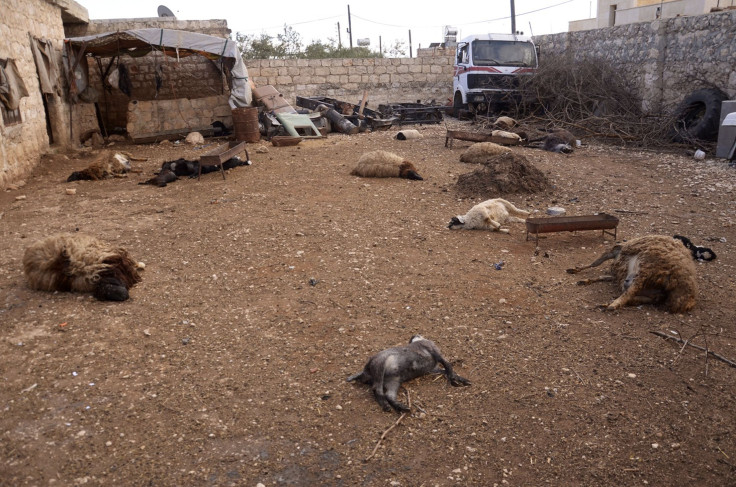Syria Chemical Weapons Program Helped By Western Companies Selling Precursor Nerve Agents

When Syria lost its main ally, Egypt, to Israel in a 1979 peace deal, the Alawite-controlled government in Damascus set out to regain its military edge by establishing a secret chemical weapons program that required the involvement of Western companies -- whether they knew it or not.
Wednesday's report by Syrian opposition groups that the Syrian military had used chemical weapons to kill 1,300 civilians outside Damascus, coupled with comparatively less horrific episodes earlier this year, indicates that the Assad regime has a large stockpile of deadly chemical weapons. Now, as the world reels in revulsion, the question presents itself: How, exactly, did that come about?
The story starts after the Yom Kippur War, when Syria realized it needed to strengthen its military capabilities, especially after losing its alliance with Egypt in the 1979 peace agreement. Syria came up with a plan called strategic parity, which sought to develop defensive and offensive capabilities to counter Israel’s nuclear weapons program, according to a research publication by Danny Shoham, a chemical and biological expert at the Begin-al-Sadat Center for Strategic Studies in Bar-Ilan University in Israel. The irony, of course, is that the Syrian government chose to use its chemical weapons not against its intended enemy, Israel, but against its own people.
One of the ways the Syrian government was able to keep its chemical weapons program undetected for so long was through the establishment of its Scientific Studies and Research Center (SSRC), ostensibly a civilian agency, set up in 1969. This science research agency acted as a front for a secret chemical weapons program in conjunction with the military, according to Shoham.
Here's a timeline of Syria's chemical weapons program and activity: Nuclear Threat Initiative provided the data.
Many Western companies have since contributed to the Syria weapons program by selling precursor nerve agents to SSRC front companies. As far back as 1989, then-CIA Director William Webster said, "West European firms were instrumental in supplying the required precursor chemicals and equipment. Without the provision of these key elements, Damascus would not have been able to produce chemical weapons."
In the early 1980s, the SSRC set up its first chemical munitions facility, called the “Borosilicate Glass Project.” It was equipped by Germany's Schott Corporation, one of the largest industrial glass manufacturers, which helped produce materials used by the Syrians for their weapons program. On Sept. 15, 1983, a National Intelligence Estimate noted that Syria was meanwhile "a major recipient of Soviet CW [chemical weapons] assistance" and that the country "probably has the most advanced chemical warfare capability in the Arab world.”
In 1992, a Damascus-based company, Setma, under the auspices of the SSRC, received a 45-ton shipment of trimethyl phosphite, a precursor to nerve gas, from a company in India, according to information provided by the Nuclear Threat Iniative, a non-proift organization with a mission to strengthen global security. A year later, Syria received at least 800 kilograms of raw materials for the production of an updated version of VX, a deadly nerve agent. It was sold to the Syrians by Anatoly Kuntsevich, an adviser to Russian President Boris Yeltsin on chemical disarmament and commander of the Russian Military Academy for Chemical Warfare.
Another German company, Sigri, which specialized in Teflon coatings for instruments in the chemical field, provided critical equipment for the Syrian weapons program in the 1990s, and British-based MW Kellogg set up plants for the manufacture of ammonia and urea -- both used in chemical weapons -- in Syria and Iran, Shoham detailed.
Even French scientific institutes played a role through their relationship with the SSRC, providing information regarding storehouses for biological and chemical weapons.
The most recent supplier to the Syrian chemical weapons program is North Korea. Besides providing the Syrian regime the means to construct a nuclear reactor, which Israel had destroyed in 2007, North Korea also has transferred technology for producing chemical warheads, selling “after-sales services,” according to the South Korean news agency Chosun Ilbo quoting a diplomatic source. In 2009, four shipping containers headed for Syria from North Korea were discovered containing 13,000 protective coats, and a 2012 report by the U.N. regarding the seizure said that the coats were “reported to have military use for chemical protection.” In addition, 23,600 gas indicators used to detect chemical substances were found.
Recent uses of chemical weapons reported by opposition forces have shown that Syrian President Bashar al-Assad is willing to use these unconventional weapons even after the recent arrival of U.N. chemical experts in the war-torn country.
Jeff White, a defense fellow at The Washington Institute, a D.C.-based think tank, said Syria probably used chemical weapons in the outskirts of Damascus because regime forces have had great difficulty breaking rebel resistance in thos areas. “The military stance using the significant use in these areas could affect the tactical military situation and could affect support for the rebels, either driving people out of the areas …or... causing the people to quit supporting rebel units,” White said.
In a sense, the attack illustrates the darkest sector of the global military industrial complex. Sadly, White observed, little has been done to curb Syria’s use of chemical weapons.
© Copyright IBTimes 2024. All rights reserved.






















